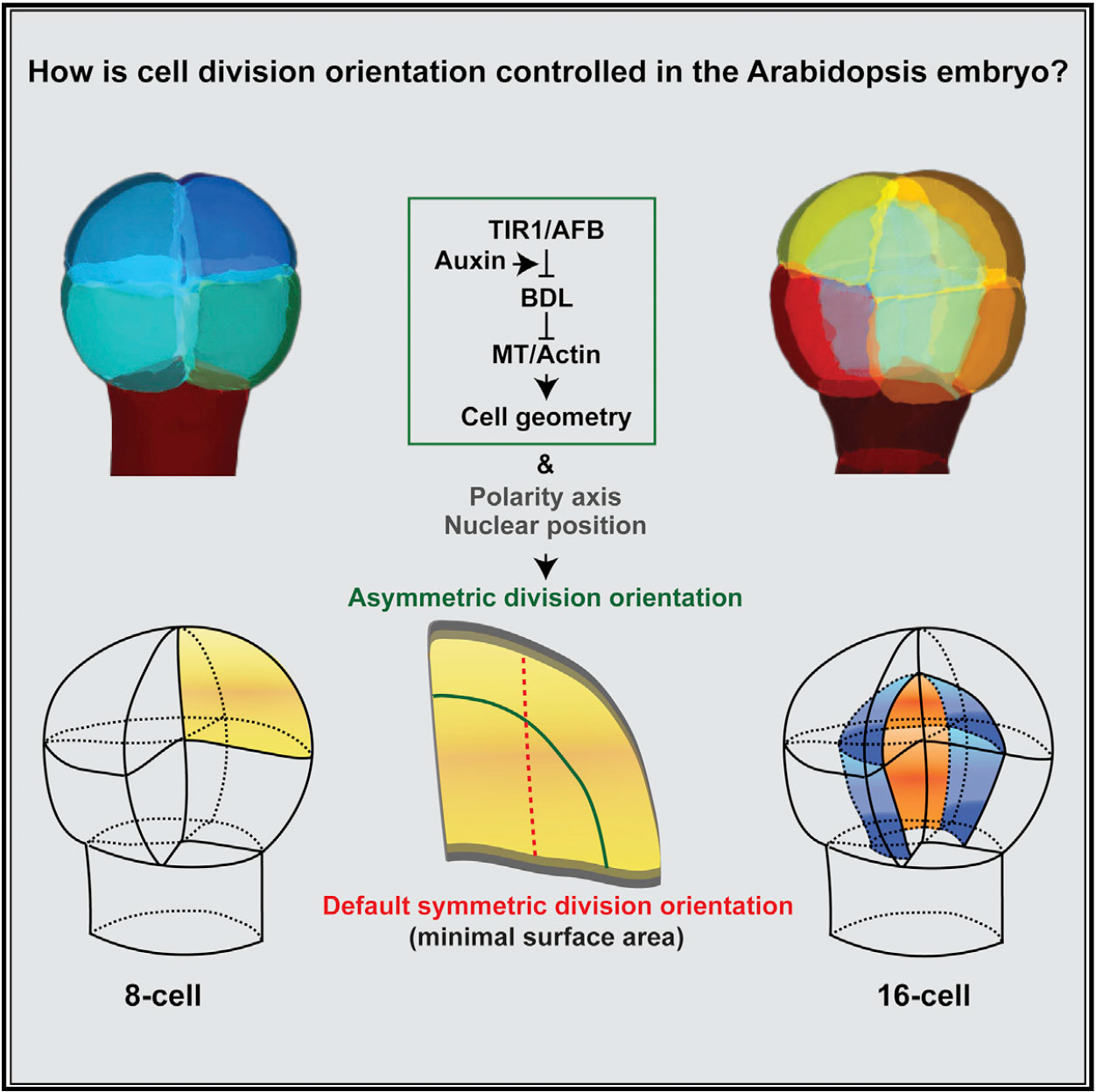博文
Current Biology:生长素依赖性的细胞骨架和细胞形状控制介导拟南芥胚胎中的分裂方向
||
Auxin-dependent control of cytoskeleton and cell shape regulates division orientation in the Arabidopsis embryo
第一作者:Prasad Vaddepalli
第一单位:荷兰瓦赫宁根大学
第一通讯:Dolf Weijers
Abstract
背景回顾:Premitotic control of cell division orientation is critical for plant development, as cell walls prevent extensive cell remodeling or migration. While many divisions are proliferative and add cells to existing tissues, some divisions are formative and generate new tissue layers or growth axes. Such formative divisions are often asymmetricin nature, producing daughters with different fates. 前期研究基础:We have previously shown that, in the Arabidopsis thaliana embryo, developmental asymmetry is correlated with geometric asymmetry, creating daughter cells of unequal volume. Such divisions are generated by division planes that deviate from a default “minimal surface area” rule. 提出问题:Inhibition of auxin response leads to reversal to this default, yet the mechanisms underlying division plane choice in the embryo have been unclear. 主要发现:Here, we show that auxin-dependent division plane control involves alterations in cell geometry, but not in cell polarity axis or nuclear position. 结果1-转录组:Through transcriptome profiling, we find that auxin regulates genes controlling cell wall and cytoskeleton properties. 结果2-MT结合蛋白:We confirm the involvement of microtubule (MT)-binding proteins in embryo division control. 结果3-MT与actin:Organization of both MT and actin cytoskeleton depends on auxin response, and genetically controlled MT or actin depolymerization in embryos leads to disruption of asymmetric divisions, including reversion to the default. 结论:Our work shows how auxin-dependent control of MT and actin cytoskeleton properties interacts with cell geometry to generate asymmetric divisions during the earliest steps in plant development. 摘 要 
在有丝分裂前对于细胞分裂方向的控制对于植物的发育至关重要,因为细胞壁阻止了广泛的细胞重塑或迁移。虽然许多分裂是增殖性的,增加现有组织中的细胞;但有些分裂是形成性的,生成新的组织层或生长轴。这种形成性分化在本质上往往是不对称的,产生了具有不同命运的子细胞。作者之前的研究已经证明,在拟南芥的胚胎中,发育不对称性与几何不对称性相关,从而产生体积不对等的子细胞。这种分裂是由于分裂平面偏离默认的“最小表面积”规则而导致的。生长素响应的抑制导致细胞分裂向这种默认规则的逆转,但胚胎中细胞分裂平面选择的机制尚不清楚。本文中,作者发现生长素依赖的分裂平面控制,涉及到细胞几何形状的改变,但不涉及细胞极性轴或核位置的改变。通过转录组分析,作者发现生长素调控与细胞壁和细胞骨架特性控制相关的基因。进一步实验显示微管结合蛋白参与了胚胎的分裂控制。微管和肌动蛋白细胞骨架的组织都依赖于生长素响应,而胚胎中遗传控制的微管或肌动蛋白解聚合会破坏不对称分裂,包括了细胞分裂逆转为默认规则。本文的工作表明了生长素依赖性的微管和肌动蛋白细胞骨架特性控制如何与细胞几何形状相互作用,从而在植物发育的早期阶段产生不对称分裂。 通讯作者 ** Dolf Weijers **
个人简介: 1997年,荷兰恩斯赫德,学士; 2002年,荷兰莱顿大学,博士; 2002-2006年,德国图宾根大学,博后。 研究方向:以拟南芥早期胚胎会材料研究细胞如何获取其特性。
doi: https://doi.org/10.1016/j.cub.2021.09.019
Journal: Current Biology
Published date: October 04, 2021
p.s. 通讯往期研究链接:
实验室介绍:Dolf Weijers Lab (荷兰瓦赫宁根大学)
Plant Reproduction: 单、双子叶模式植物(短柄草 v.s. 拟南芥)胚胎发生的时序比较转录组分析
PNAS:拟南芥中介导ARF转录因子结合的DNA元件结构基础
Nature Plants:苔藓植物地钱中的最小化生长素响应系统
Development:拟南芥胚胎发生早期维管组织特化的调控网络鉴定
Nature Plants:SOSEKI蛋白影响拟南芥植株整体极性
Plant Cell:bHLH转录因子调控网络介导拟南芥胚和胚柄发育
https://blog.sciencenet.cn/blog-3158122-1307702.html
上一篇:Current Biology:硝酸盐信号通过激活GA生物合成来促进植物生长
下一篇:the plant journal:一个新的LRR-RLK基因CTLK1作用于苜蓿的低温抗性
全部作者的其他最新博文
- • Plant Physiology:CsMADS3促进柑果中的叶绿素降解和类胡萝卜素合成(华中农业大学)
- • Molecular Plant:LBD11-ROS反馈调节作用于拟南芥的维管形成层增殖和次生生长(浦项科技大学)
- • Science Advances:根结线虫通过调控植物的CLE3-CLV1模块,促进侵染进程(日本熊本大学)
- • Nature Communications:油菜素内酯参与植物营养生长期转变的分子机制解析(浙江农林大学)
- • Current Biology:光合作用产生的蔗糖驱动侧根“生物钟”(德国弗莱堡大学)
- • PNAS:花同源异型基因在叶中被抑制、花中被激活的分子机制(南卡罗来纳大学)